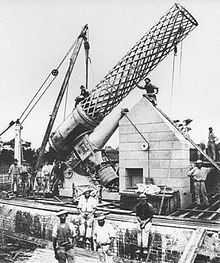User:Aoifeboylan19/sandbox
Howard Grubb[edit]
Legacy[edit]
Professional Legacy[edit]
Following the production and introduction of the largest and best known telescopes of the Victorian era, the Grubb brothers landed themselves at the forefront of optical and mechanical engineering solidifying their legacy for centuries to come. The Grubbs - Howard and his father Thomas - spent decades supplying astronomical instruments to the world, with their work and inventions paving the way for how optical and mechanical engineering is carried out, executed and received. Their work also influenced the way in which many of the devices and telescopes used in these mechanisms and processes are utilized. [1]

In 1900, Howard Grubb introduced the reflector of reflex sight, a non-magnifying optical sight that uses a collimator to allow the viewer looking through the sight to see an illuminated image of a reticle or other pattern in front of them. This type of sight has come to be used on all kinds of devices from firearms to large fighter aircraft. It is also a fundamental element of head-up displays and continues to be the blueprint for many similar devices. Following this work, Grubb quickly gained the reputation for being a first class producer of telescopes and astronomical devices, while simultaneously inspiring many aspiring engineers. [2]
Under Howard Grubb - The Grubb Telescope Company, he gained an even greater reputation for quality optical instruments. Grubb assisted with the construction of a 48-inch reflector for Melbourne, completed in 1867 which is still widely used to this day in Australia and internationally. In 1914, Grubb moved his business to England, where in 1925, as the result of a merger, it became Sir Howard Grubb, Parsons & Company further widening the reach of his work. Grubb's astronomical work was also used for research and articles written about NASA, further displaying the legacy and scope of his work. [3]
Personal Legacy[edit]
In addition to his optical and mechanical engineering work, Grubb was awarded a Society award in the early 1990's (1912) for his contribution to the Royal Society and the Royal Astronomical Society. He was a longtime and loyal member of the Royal Dublin Society serving as honorary secretary and also vice-president, which both attributed to this award. He also received the Cunningham gold medal in 1881, and a Boyle medal. In 1913, he was given the tittle of scientific adviser as a result of his contribution to the Commissioners of Irish Lights. He was a member of the Royal Institute of Engineers of Ireland, and held an honorary degree in Master of Engineering.[4]
Grubb died in the year 1931, leaving six children and a vast amount of knowledge and instruments behind, along with the planning for a floating telescope. [5]
References[edit]
- ^ Glass, I. S. (1997). Victorian telescope makers: The lives and letters of Thomas and Howard Grubb. Bristol, UK: Institute of Physics Pub.
- ^ Murray, J. (1906). Science progress. Oxford, Edinburgh. Blackwell Scientific Publications.
- ^ Glass, I. S. (1997). Victorian telescope makers: The lives and letters of Thomas and Howard Grubb. Bristol, UK: Institute of Physics Pub.
- ^ “Grace's Guide" (2018, January 8). Howard Grubb. Retrieved from www.gracesguide.co.uk/Howard_Grubb.
- ^ Grubb, R. (1995, October). Sir Howard Grubb maker of the McClean 10 inch telescope. Retrieved from https://web.archive.org/web/20070205035540/http://www.projects.ex.ac.uk/nlo/news/nlonews/1995-01/9501-12.htm
